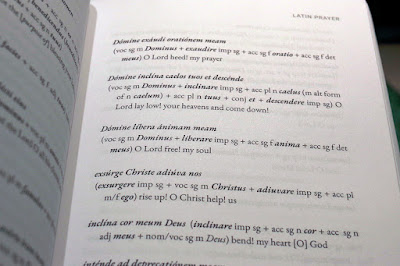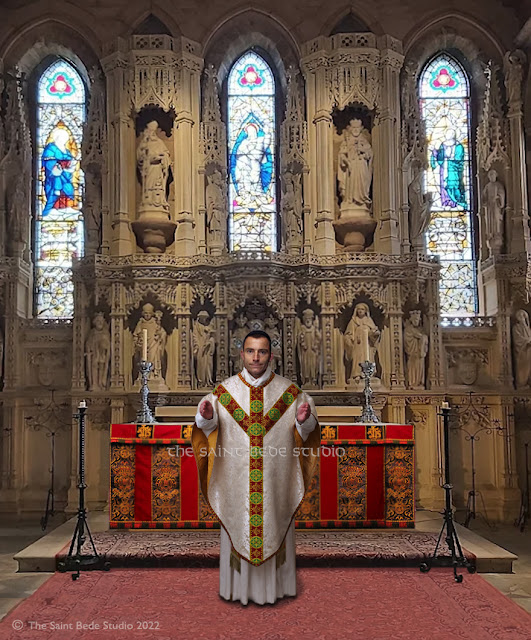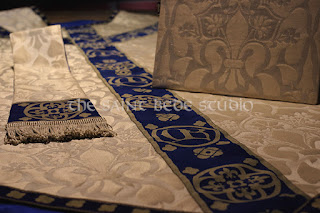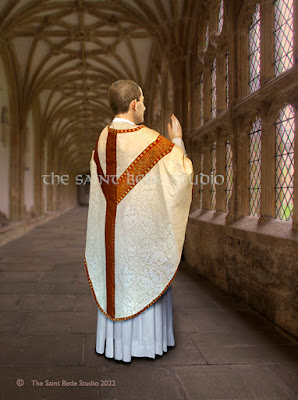Wednesday 31 August 2022
Praying in Latin : Book Review
Monday 29 August 2022
Vestments in the Gothic Revival Style
The vestments were made from a brocade in a lovely shade of cream and were lined in a golden silk taffeta. The ornament was formed from one of the Studio's unique braids, named Saint Chad.
Please click on the images for an enlarged view.
Enquiries at this page.
Sunday 28 August 2022
Saint Andrew's Abbey-Church Brugges (Belgium)
 |
| Photograph: Dirk Vde 2007 Please note: The above copyrighted image may not be reproduced in any circumstances. |
The altar rests beneath a magnificent civory or ciborium, the vault of which is covered with golden mosaic tiles. The apse walls are treated with inlaid marblework and murals painted in the Beuronese school of sacred art. Equally magnificent is the Cosmatesque floor of the sanctuary.

The charming photograph adjacent was taken in the Abbey Church of Saint Andrew in Bruges, Belgium around 1958. A Benedictine monk is pictured at the beginning of a Low Mass, attended by two servers.
Click on the images for an enlarged view.
Thursday 25 August 2022
For Zealous Shepherds
So, good Lord, do now in like manner again with your Church militant; change and make the soft and slippery earth into hard stone; set in your Church strong and mighty pillars that may suffer and endure great labours, watching, poverty, thirst, hunger, cold and heat; which also shall not fear the threatening of princes, persecution, neither death but always persuade and think with themselves to suffer with a good will, slanders, shame, and all kinds of torments, for the glory and laud of your Holy Name. By this manner, good Lord, the truth of your Gospel shall be preached throughout all the world.
Therefore, merciful Lord, exercise your mercy, show it indeed upon your Church. Amen.
Monday 15 August 2022
On the Feast of the Assumption of the Blessed Virgin
These vestments are made in the Gothic Revival style from a beautiful English brocade in a shade of ivory. The vestments are lined in Royal Blue coloured taffeta and ornamented with one of the Studio's unique Marian braids.
Please click on the images for an enlarged view.
Enquiries : This page.
Tuesday 2 August 2022
Priestly Ordinations 2021 : 7
These Gothic Revival vestments were made from an ecclesiastical brocade in a lovely shade of ivory, and ornamented with the Studio's unique braids. The wider braid illustrated is called Welby and is a replica of an orphrey designed by the famed English Gothic Revivalist A.W.N. Pugin. The orphrey braid was enhanced with a quatrefoil galloon in red and gold. The lining of these vestments was formed from a golden shade of taffeta.
Please pray for all newly-ordained priests.
Click on the images for an enlarged view.
Enquiries : This page.
AMDG

















